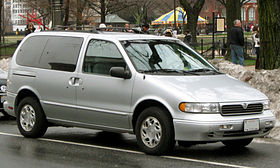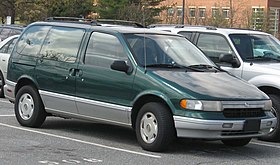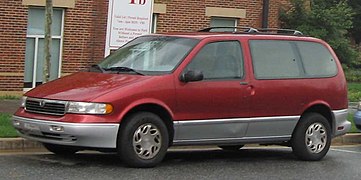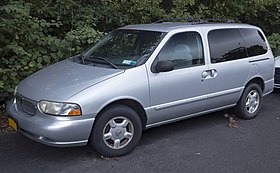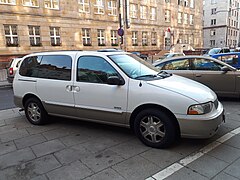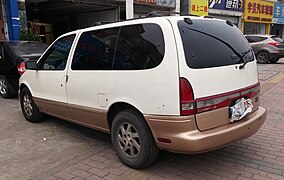
Minivan is a car classification for vehicles designed to transport passengers in the rear seating row(s), with reconfigurable seats in two or three rows. The equivalent classification in Europe is MPV or M-segment.

Mercury was a brand of mid-priced automobiles produced by American manufacturer Ford Motor Company between 1938 and 2011 with 1939 being the first model year. It stood as its own line within Ford until 1945, and thereafter formed half of Ford's Lincoln-Mercury Division. Created by Edsel Ford in 1938 to bridge the gap between the Ford and Lincoln model lines, its principal competition was General Motors' Buick and Oldsmobile divisions, and Chrysler Corporation's DeSoto and Chrysler brands.

The Ford Windstar is a minivan that was produced and sold by Ford. The replacement for the Ford Aerostar, the Windstar adopted the front-wheel drive configuration of the Chrysler minivans. From the 1995 to 2007 model years, three generations of the model line were sold, with the final generation renamed as the Ford Freestar.

The Ford Country Squire is a series of full-size station wagons that were assembled by American automaker Ford. Positioned as the top-level station wagon of the Ford division, the Country Squire was distinguished by woodgrain bodyside trim. From 1950 through the 1991 model years, eight generations of the Country Squire were produced. Following the discontinuation of Edsel Bermuda, Mercury marketed the Mercury Colony Park as a divisional counterpart of the Country Squire, sharing bodywork and trim while the Mercury was not available with a six cylinder engine and was more expensive due to the optional equipment on the Ford that was standard on the Mercury.

Mercury Cougar is a nameplate applied to a diverse series of automobiles sold by the Mercury division of Ford from 1967 until 1997 and from 1999 through 2002 model years. While the nameplate is associated with two-door coupes, at various times during its production, the Cougar was also marketed as a convertible, four-door sedan, station wagon, and a hatchback.

The Chrysler minivans are a series of minivans that have been produced and marketed by the American automaker Chrysler since the 1984 model year. Currently in its sixth generation, the model line is marketed worldwide, primarily in North America and Europe. Introduced as the Dodge Caravan and Plymouth Voyager, the Chrysler minivans have been marketed under a variety of nameplates under the Chrysler, Plymouth, Dodge, and Ram brands; through the use of rebadging, the model line has also been marketed under the Lancia and Volkswagen brands.
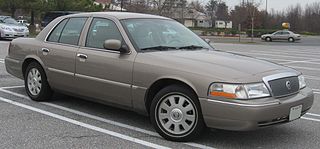
The Mercury Grand Marquis is an automobile that was sold by Mercury from 1975 to 2011. Introduced as the flagship sub-model of the Mercury Marquis, the Grand Marquis became a stand-alone model line for 1983, serving as the largest Mercury sedan. Subsequently, the model line would serve as the sedan counterpart of the Mercury Colony Park station wagon; it would later serve as the basis of the revived Mercury Marauder.
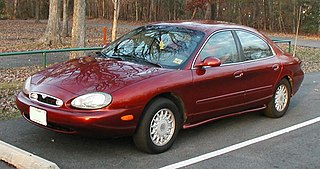
The Mercury Sable is a range of automobiles manufactured and marketed by the Mercury brand of Ford Motor Company. Introduced on December 26, 1985, as the replacement for the Mercury Marquis, the Sable marked the transition of the mid-size Mercury product range to front-wheel drive.

The Chrysler Town & Country is a minivan that was manufactured and marketed by Chrysler from 1990 to the 2016 model years. The third Chrysler minivan introduced in North America, the Town & Country adopted its nameplate from the flagship Chrysler station wagon line, adopting its exterior woodgrain trim as a design feature for several generations.

The Ford Aerostar is a range of vans that was manufactured by Ford from the 1986 to the 1997 model years. The first minivan produced by Ford, the model line was marketed against the Chevrolet Astro/GMC Safari and the first two generations of the Chrysler minivans. Introduced shortly before the Ford Taurus, the Aerostar derived its name from its slope-nosed "one-box" exterior.

The Chevrolet Lumina APV is a minivan that was produced by the Chevrolet division of General Motors. The first front-wheel drive minivan sold by Chevrolet, the Lumina APV was sold in a single generation from the 1990 to 1996 model years. Marketed alongside the Pontiac Trans Sport and Oldsmobile Silhouette, the Lumina APV competed against the Dodge Grand Caravan/Plymouth Grand Voyager, the extended-length Ford Aerostar, and the Mazda MPV.
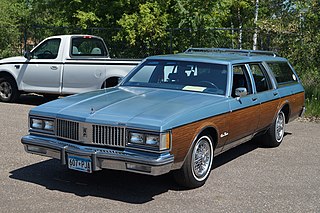
The Oldsmobile Custom Cruiser is an automobile that was manufactured and marketed by Oldsmobile from 1971 until 1992. Marking the return of Oldsmobile to the full-size station wagon segment, the Custom Cruiser was initially slotted above the intermediate Oldsmobile Vista Cruiser, ultimately above the later mid-size Oldsmobile Cutlass Cruiser.

The Mercury Colony Park is an American luxury full-size station wagon that was marketed by the Mercury division of Ford Motor Company between 1957 and 1991. Distinguished by its simulated wood-grain paneling, the Colony Park was marketed as either the premium-trim or the sole full-size station wagon offering of the division. Following the 1960 demise of Edsel, full-size Mercury vehicles shared bodywork with Ford; the Colony Park served as the counterpart of the Ford Country Squire through 1991.

The Nissan Quest is a minivan manufactured and marketed by Nissan for model years 1993–2017 over four generations.

The Chrysler Town & Country is an automobile which was manufactured by Chrysler from 1940 to 1942 and from 1945 to 1988 with production interrupted during World War II. Primarily produced as a luxury station wagon, the Town & Country was also available in "woodie" four-door sedan, two-door hardtop and convertible body styles from 1947 to 1950, 1968 to 1969 and from 1983 to 1986. The 1988 model year was the last for the station wagon until the 1990 model year when Chrysler reintroduced the Town & Country nameplate as the rebadged variant Chrysler Town & Country minivan.

The Edsel Villager is a station wagon that was produced and sold by Edsel from 1958 to 1960. Like the two-door Roundup and premium Bermuda station wagons, the Villager was initially built on a 116 in wheelbase shared with Ford's station wagons, and, throughout its lifespan, shared Ford's wagons core body stampings. The Villager and the Ranger were the only two model names that existed throughout Edsel's three-year life span as an automobile marque.
The Ford Carousel is a prototype vehicle that was developed by Ford in 1973. A derivative of the third-generation Ford Econoline/Club Wagon, the Carousel explored a number of the concepts that 1980s American-market minivans later put into production, serving as an alternative to both full-size station wagons and passenger vans.

The first-generation Chrysler minivans are a series of minivans produced and marketed by the Chrysler Corporation from the 1984 to the 1990 model years. Introduced as the first minivans from an American-brand manufacturer and popularizing the minivan as a vehicle, the Dodge Caravan and Plymouth Voyager were launched ahead of chief competitors Chevrolet Astro/GMC Safari and Ford Aerostar.
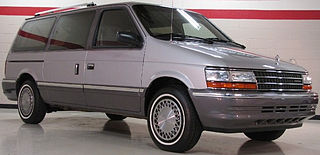
The second-generation Chrysler minivans are a series of minivans that were manufactured and marketed by Chrysler Corporation in North America and Europe from 1991 to 1995. Officially designated the AS platform by Chrysler, the second-generation minivans were an extensive revision of the first-generation chassis and body. As before, passenger and cargo configurations were sold by Dodge, Plymouth, and Chrysler divisions. The first minivans offered with driver-side airbags and with optional integrated child safety seats, the second-generation Chrysler minivans offered all-wheel drive as an option for the first time; a manual transmission would be offered for the last time in the North American market.

The third-generation Chrysler minivans are a series of passenger minivans that were marketed by the Chrysler Corporation from the 1996 to 2000 model years. The first ground-up redesign of the model lines since their introduction, designers added a further degree of divisional identity between the Plymouth Voyager, Dodge Caravan, and Chrysler Town & Country. In a notable change, the cargo van was discontinued, with all examples sold as passenger vans. Coinciding with the retirement of the Plymouth brand during 2001, this is the final generation marketed as the Plymouth Voyager.
